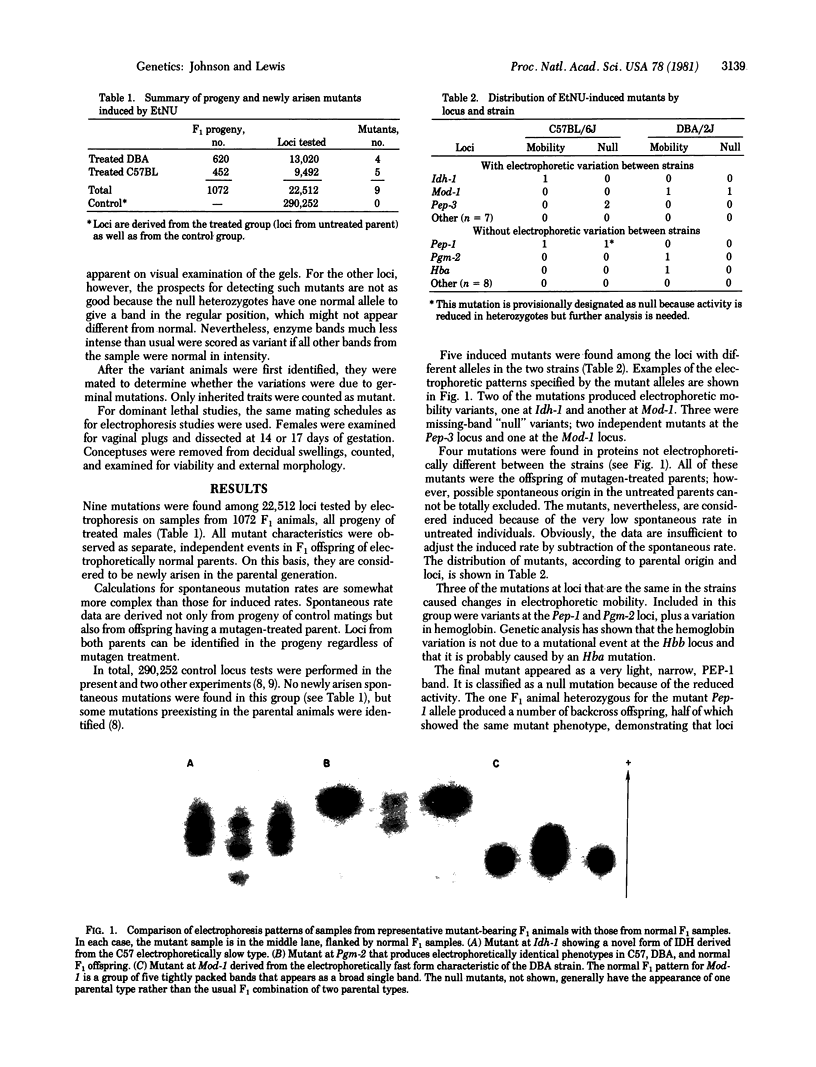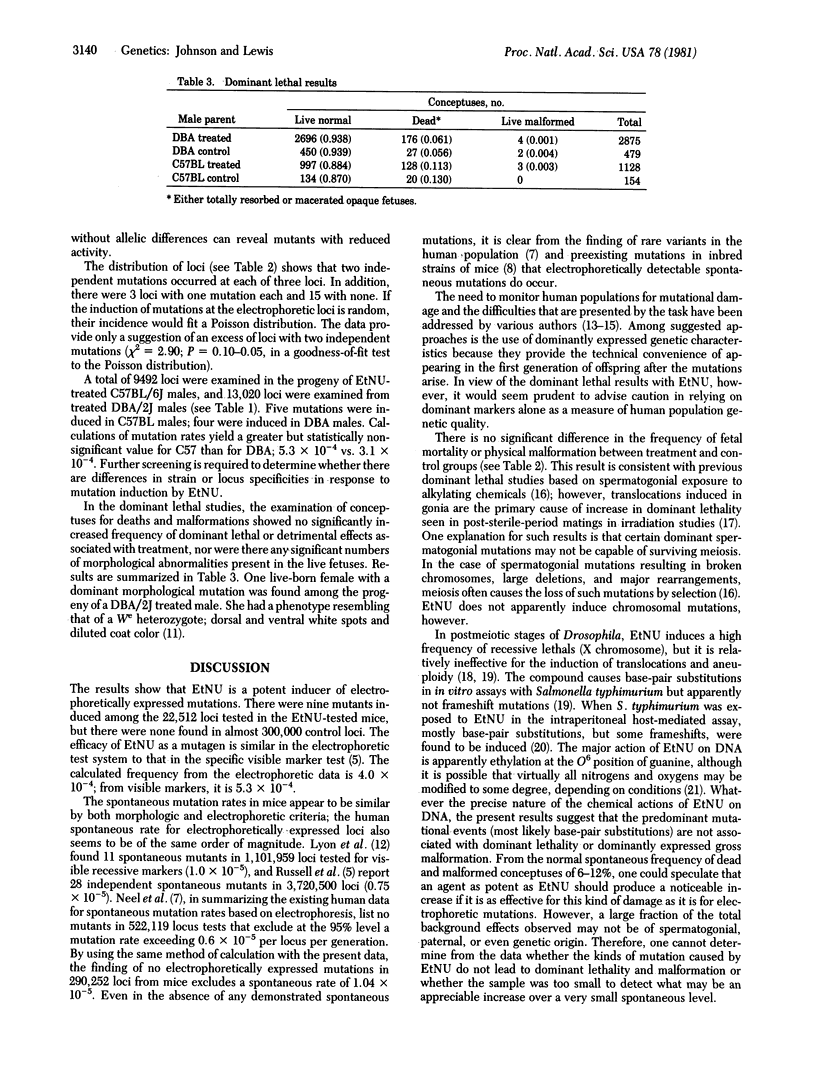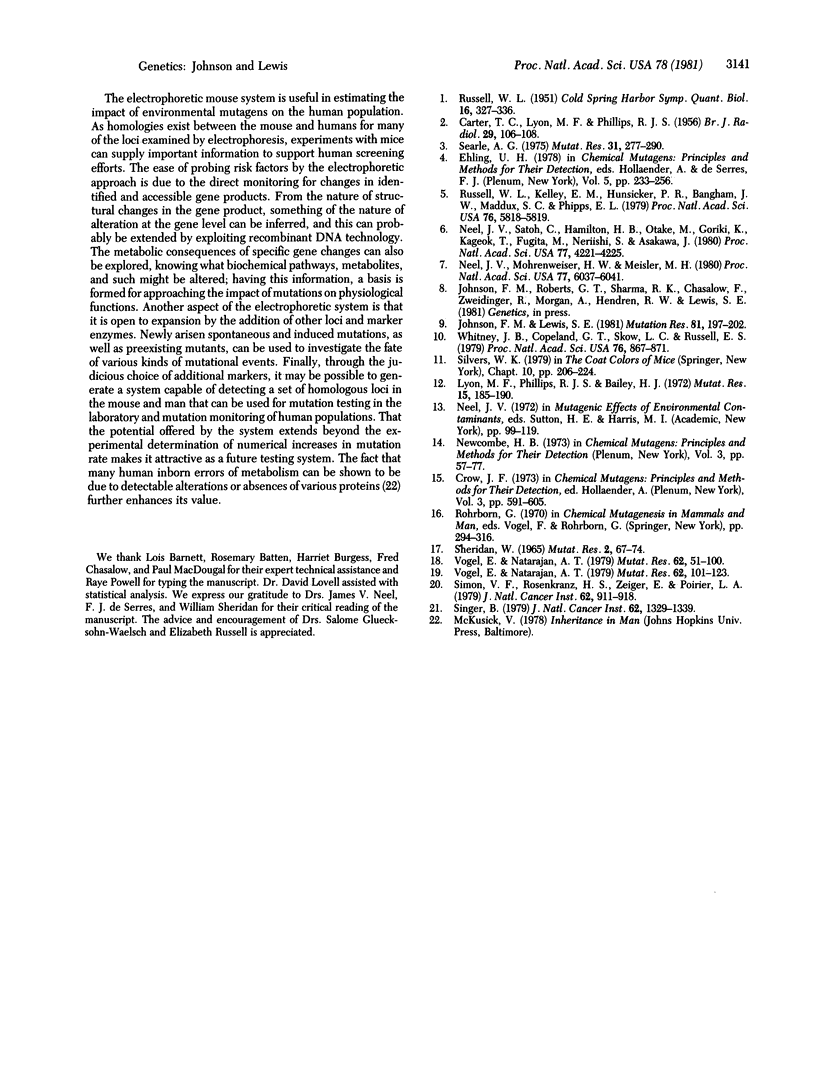Abstract
Male DBA/2J and C57BL/6J mice were treated with ethylnitrosourea (EtNU) at a dose of 250 mg/kg of body weight. After a sterile period of 11 weeks, the treated animals were mated with untreated females; treated DBA with C57 and treated C57 with DBA. A small control group of untreated males was established, and a larger control group from earlier experiments was also used for comparison. Tissue samples removed surgically from the parents and F1 offspring were examined by electrophoresis. Nine newly arisen mutants attributable to induction by EtNU were found in 22,512 loci tested for mutation. No mutations were encountered in 290,252 control locus tests. A preliminary study conducted concomitantly with the electrophoretic analyses for dominant lethal effects and physical malformation showed no increase over background due to EtNU treatment of spermatogonia, which suggests that mutations induced by EtNU tend not to be expressed in this way. The nature of the mutants identified by electrophoresis facilitates follow-up analyses leading to increased understanding of the molecular basis and the physiological effects of induced mutations in mammalian organisms.
Full text
PDF



Images in this article
Selected References
These references are in PubMed. This may not be the complete list of references from this article.
- CARTER T. C., LYON M. F., PHILLIPS R. J. Induction of mutations in mice by chronic gamma irradiation; interim report. Br J Radiol. 1956 Feb;29(338):106–108. doi: 10.1259/0007-1285-29-338-106. [DOI] [PubMed] [Google Scholar]
- Johnson F. M., Lewis S. E. Mouse spermatogonia exposed to a high, multiply fractionated dose of a cancer chemotherapeutic drug: mutation analysis by electrophoresis. Mutat Res. 1981 Apr;81(2):197–202. doi: 10.1016/0027-5107(81)90034-8. [DOI] [PubMed] [Google Scholar]
- Lyon M. F., Phillips R. J., Bailey H. J. Mutagenic effects of repeated small radiation doses to mouse spermatogonia. I. Specific-locus mutation rates. Mutat Res. 1972 Jun;15(2):185–190. doi: 10.1016/0027-5107(72)90031-0. [DOI] [PubMed] [Google Scholar]
- Neel J. V., Mohrenweiser H. W., Meisler M. H. Rate of spontaneous mutation at human loci encoding protein structure. Proc Natl Acad Sci U S A. 1980 Oct;77(10):6037–6041. doi: 10.1073/pnas.77.10.6037. [DOI] [PMC free article] [PubMed] [Google Scholar]
- Neel J. V., Satoh C., Hamilton H. B., Otake M., Goriki K., Kageoka T., Fujita M., Neriishi S., Asakawa J. Search for mutations affecting protein structure in children of atomic bomb survivors: preliminary report. Proc Natl Acad Sci U S A. 1980 Jul;77(7):4221–4225. doi: 10.1073/pnas.77.7.4221. [DOI] [PMC free article] [PubMed] [Google Scholar]
- RUSSELL W. L. X-ray-induced mutations in mice. Cold Spring Harb Symp Quant Biol. 1951;16:327–336. doi: 10.1101/sqb.1951.016.01.024. [DOI] [PubMed] [Google Scholar]
- Russell W. L., Kelly E. M., Hunsicker P. R., Bangham J. W., Maddux S. C., Phipps E. L. Specific-locus test shows ethylnitrosourea to be the most potent mutagen in the mouse. Proc Natl Acad Sci U S A. 1979 Nov;76(11):5818–5819. doi: 10.1073/pnas.76.11.5818. [DOI] [PMC free article] [PubMed] [Google Scholar]
- Searle A. G. The specific locus test in the mouse. Mutat Res. 1975 Oct;31(5):277–290. doi: 10.1016/0165-1161(75)90093-x. [DOI] [PubMed] [Google Scholar]
- Sheridan W. The induction by x-irradiation of dominant lethal mutations in spermatogonia of mice. Mutat Res. 1965 Feb;2(1):67–74. doi: 10.1016/0027-5107(65)90009-6. [DOI] [PubMed] [Google Scholar]
- Simmon V. F., Rosenkranz H. S., Zeiger E., Poirier L. A. Mutagenic activity of chemical carcinogens and related compounds in the intraperitoneal host-mediated assay. J Natl Cancer Inst. 1979 Apr;62(4):911–918. [PubMed] [Google Scholar]
- Singer B. N-nitroso alkylating agents: formation and persistence of alkyl derivatives in mammalian nucleic acids as contributing factors in carcinogenesis. J Natl Cancer Inst. 1979 Jun;62(6):1329–1339. [PubMed] [Google Scholar]
- Vogel E., Natarajan A. T. The relation between reaction kinetics and mutagenic action of mono-functional alkylating agents in higher eukaryotic systems. I. Recessive lethal mutations and translocations in Drosophila. Mutat Res. 1979 Aug;62(1):51–100. doi: 10.1016/0027-5107(79)90223-9. [DOI] [PubMed] [Google Scholar]
- Vogel E., Natarajan A. T. The relation between reaction kinetics and mutagenic action of mono-functional alkylating agents in higher eukaryotic systems. II. Total and partial sex-chromosome loss in Drosophila. Mutat Res. 1979 Aug;62(1):101–123. doi: 10.1016/0027-5107(79)90224-0. [DOI] [PubMed] [Google Scholar]
- Whitney J. B., 3rd, Copland G. T., Skow L. C., Russell E. S. Resolution of products of the duplicated hemoglobin alpha-chain loci by isoelectric focusing. Proc Natl Acad Sci U S A. 1979 Feb;76(2):867–871. doi: 10.1073/pnas.76.2.867. [DOI] [PMC free article] [PubMed] [Google Scholar]



